Abstract
This report describes the effects of gonadotropin-releasing hormone (GnRH; gonadoliberin) and an agonist, [D-Ala6, des-Gly10]GnRH ethyl amide (GnRHa), on phospholipid metabolism in rat granulosa cells isolated from mature Graafian follicles. As indicated by the incorporation of 32PO4, GnRHa rapidly (less than 2 min) stimulated the labeling of phosphatidic acid and phosphatidylinositol but had no effect on the labeling of other phospholipids. Increased phosphatidylinositol labeling was also observed when myo-[2-3H]inositol was incubated with granulosa cells in the presence of GnRHa. Increases in labeling were dependent on the dose of GnRH and time of incubation. Thyrotropin-releasing hormone and a specific GnRH antagonist had no effect on labeling, but a GnRH antagonist prevented the stimulatory action of GnRH. In addition, treatment with GnRHa slightly increased the levels of phosphatidylinositol (15%) in 60-min incubations but had no effect on the levels of other phospholipids. Significant increases in progesterone accumulation were observed after 30 min of incubation with GnRHa, and further increases were correlated with the time of incubation. The stimulatory action of GnRH on phospholipid metabolism and progesterone accumulation was not related to increases in cyclic nucleotide accumulation. In incubations lasting up to 30 min, GnRHa had no effect on cAMP accumulation. However, a transient decrease in cGMP levels was observed in response to GnRHa. These studies suggest that the rapid and specific effects of GnRH on phospholipid metabolism in rat granulosa cells represent early events in the action of GnRH.
Full text
PDF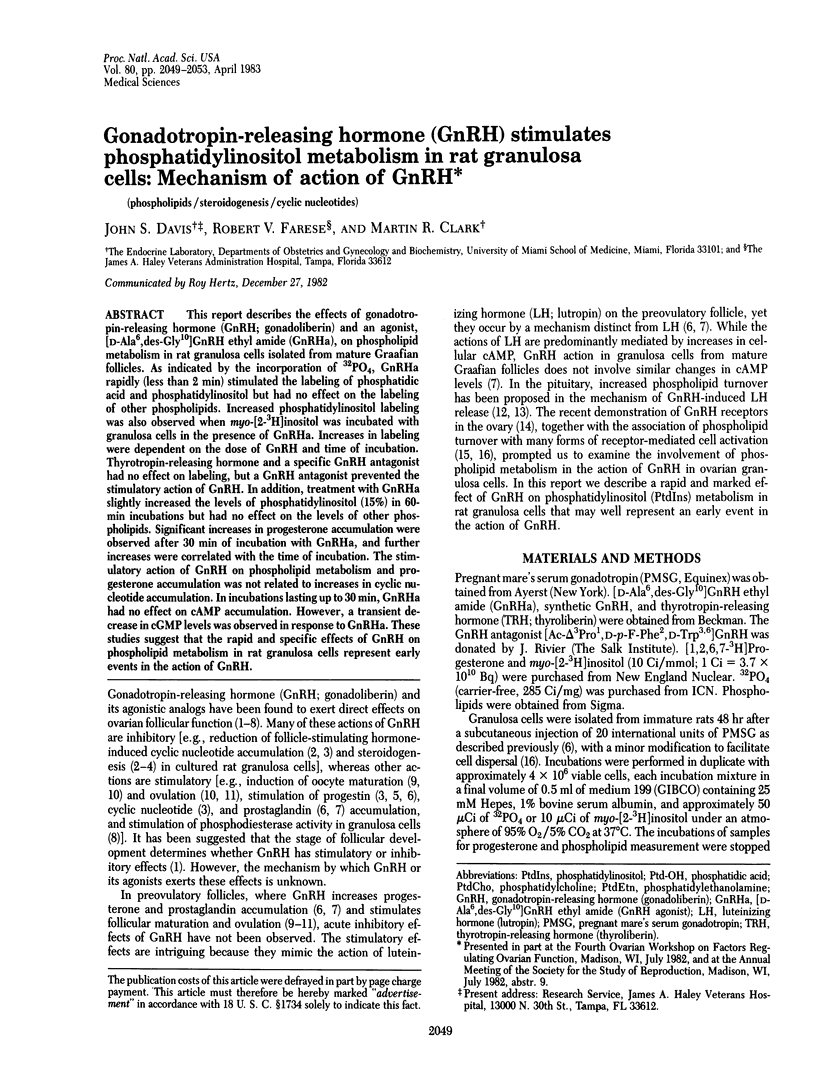
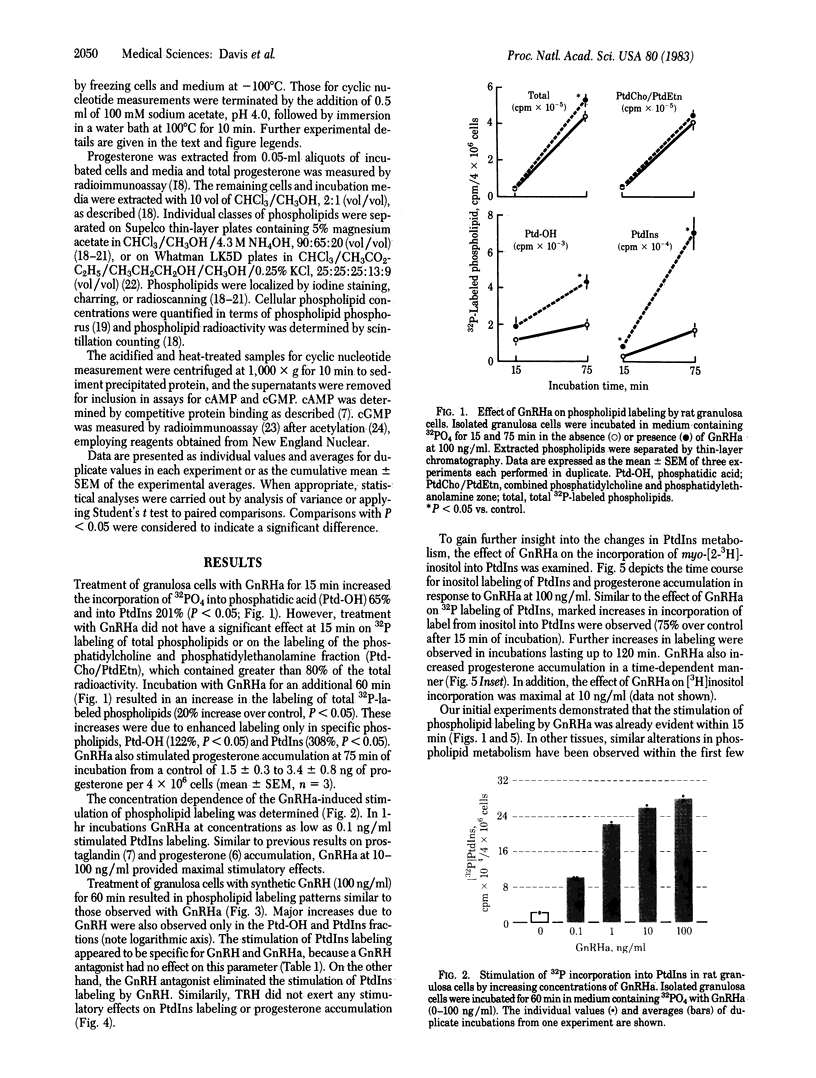
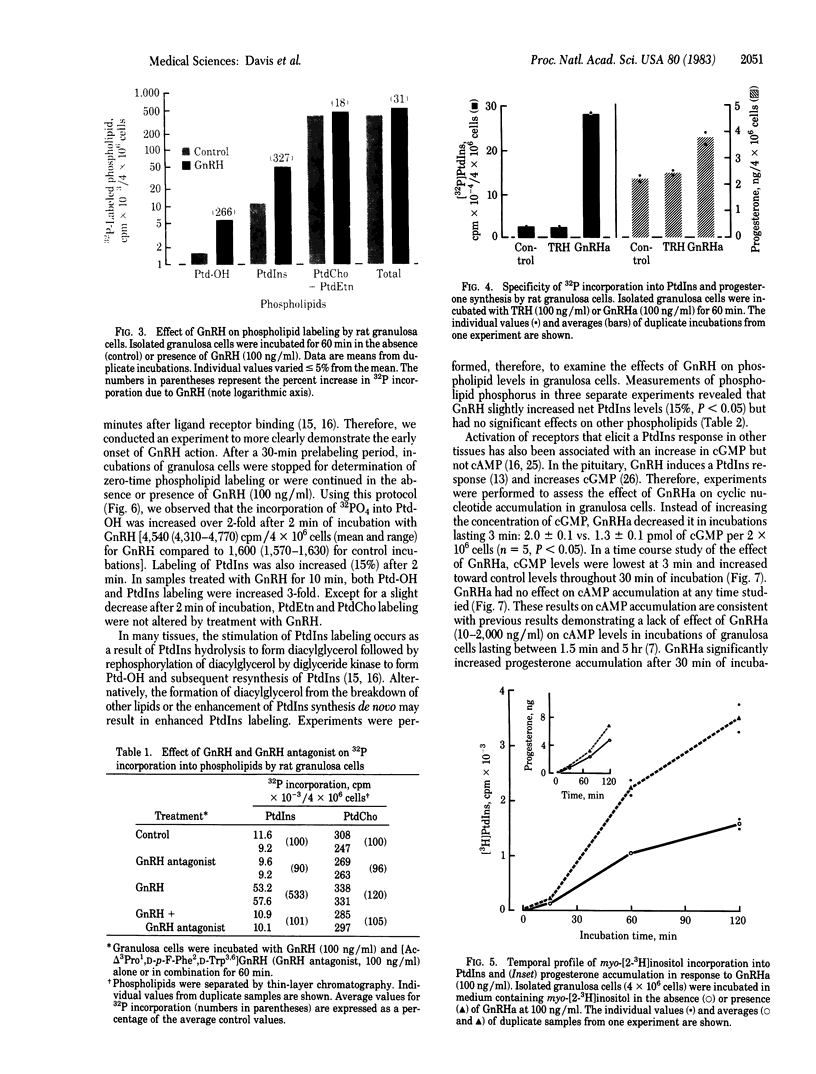
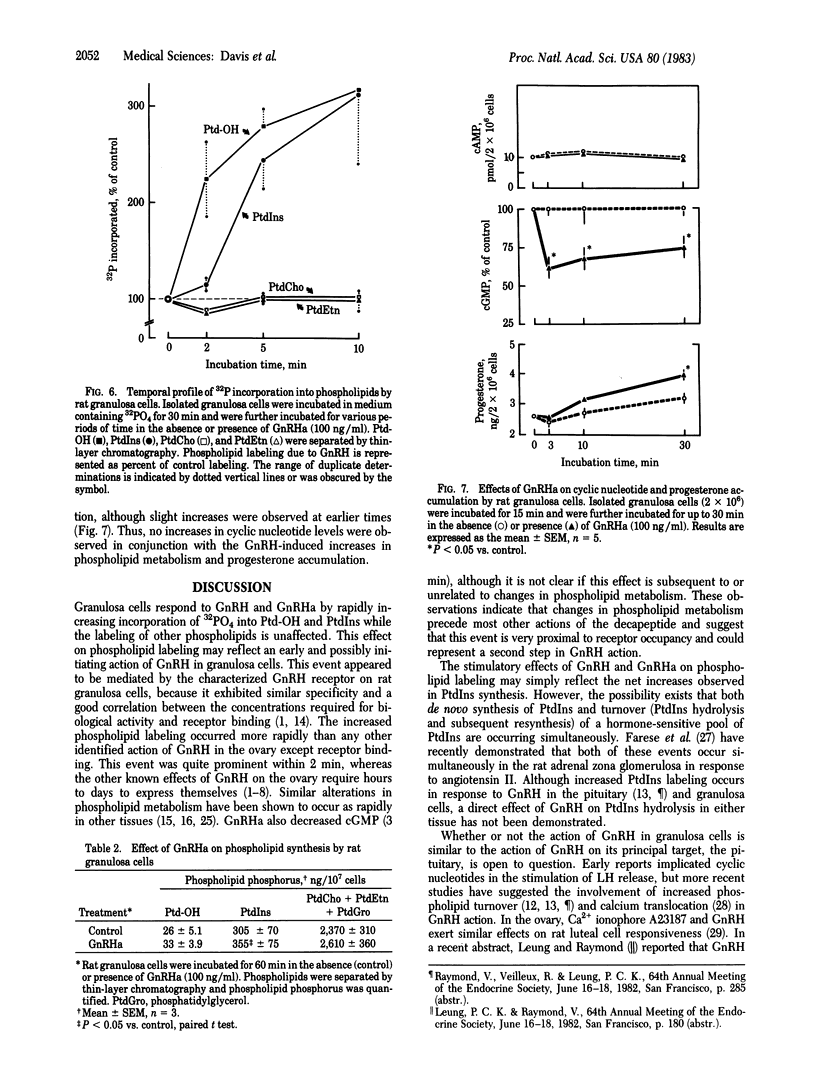
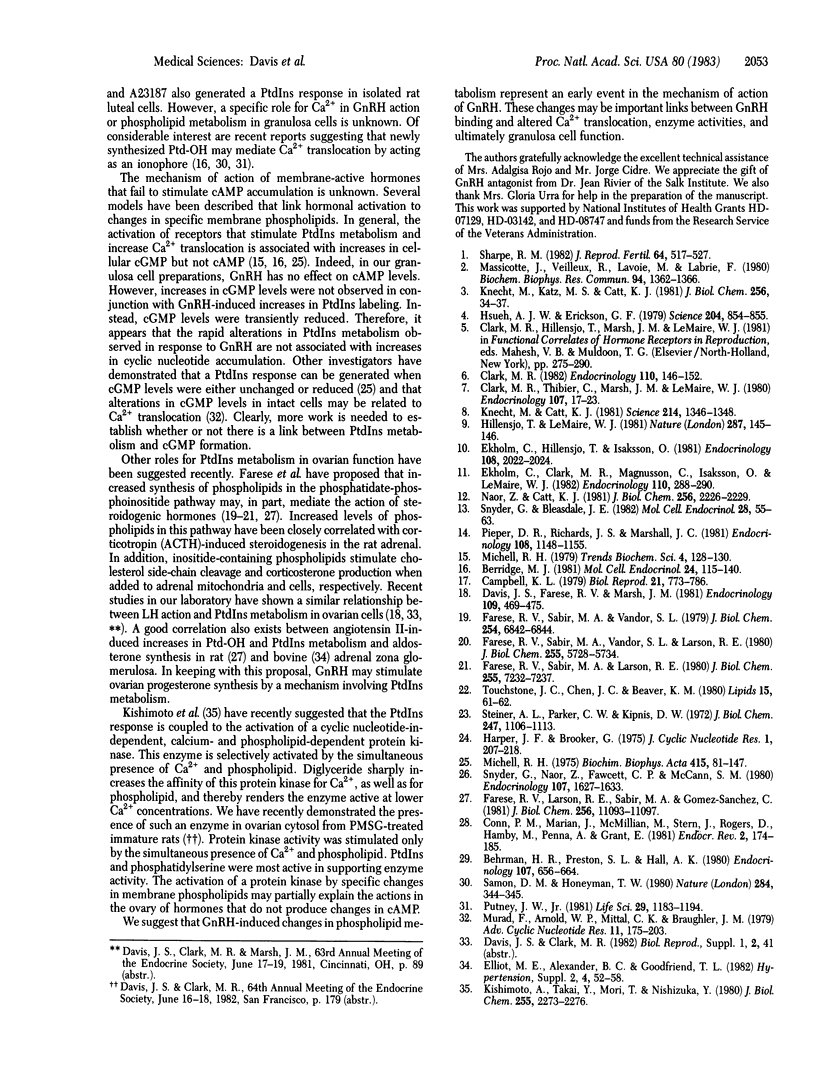
Images in this article
Selected References
These references are in PubMed. This may not be the complete list of references from this article.
- Behrman H. R., Preston S. L., Hall A. K. Cellular mechanism of the angtigonadotropic action of luteinizing hormone-releasing hormone in the corpus luteum. Endocrinology. 1980 Sep;107(3):656–664. doi: 10.1210/endo-107-3-656. [DOI] [PubMed] [Google Scholar]
- Berridge M. J. Phosphatidylinositol hydrolysis: a multifunctional transducing mechanism. Mol Cell Endocrinol. 1981 Nov;24(2):115–140. doi: 10.1016/0303-7207(81)90055-1. [DOI] [PubMed] [Google Scholar]
- Campbell K. L. Ovarian granulosa cells isolated with EGTA and hypertonic sucrose: cellular integrity and function. Biol Reprod. 1979 Nov;21(4):773–786. doi: 10.1095/biolreprod21.4.773. [DOI] [PubMed] [Google Scholar]
- Clark M. R. Stimulation of progesterone and prostaglandin E accumulation by luteinizing hormone-releasing hormone (LHRH) and LHRH analogs in rat granulosa cells. Endocrinology. 1982 Jan;110(1):146–152. doi: 10.1210/endo-110-1-146. [DOI] [PubMed] [Google Scholar]
- Clark M. R., Thibier C., Marsh J. M., LeMaire W. J. Stimulation of prostaglandin accumulation by luteinizing hormone-releasing hormone (LHRH) and LHRH analogs in rat granulosa cells in vitro. Endocrinology. 1980 Jul;107(1):17–23. doi: 10.1210/endo-107-1-17. [DOI] [PubMed] [Google Scholar]
- Conn P. M., Marian J., McMillian M., Stern J., Rogers D., Hamby M., Penna A., Grant E. Gonadotropin-releasing hormone action in the pituitary: a three step mechanism. Endocr Rev. 1981 Spring;2(2):174–185. doi: 10.1210/edrv-2-2-174. [DOI] [PubMed] [Google Scholar]
- Davis J. S., Farese R. V., Marsh J. M. Stimulation of phospholipid labeling and steroidogenesis by luteinizing hormone in isolated bovine luteal cells. Endocrinology. 1981 Aug;109(2):469–475. doi: 10.1210/endo-109-2-469. [DOI] [PubMed] [Google Scholar]
- Ekholm C., Clark M. R., Magnusson C., Isaksson O., LeMaire W. J. Ovulation induced by a gonadotropin releasing hormone analog in hypophysectomized rats involves prostaglandins. Endocrinology. 1982 Jan;110(1):288–290. doi: 10.1210/endo-110-1-288. [DOI] [PubMed] [Google Scholar]
- Ekholm C., Hillensjö T., Isaksson O. Gonadotropin releasing hormone agonists stimulate oocyte meiosis and ovulation in hypophysectomized rats. Endocrinology. 1981 May;108(5):2022–2024. doi: 10.1210/endo-108-5-2022. [DOI] [PubMed] [Google Scholar]
- Elliott M. E., Alexander R. C., Goodfriend T. L. Aspects of angiotensin action in the adrenal. Key roles for calcium and phosphatidyl inositol. Hypertension. 1982 May-Jun;4(3 Pt 2):52–58. [PubMed] [Google Scholar]
- Farese R. V., Larson R. E., Sabir M. A., Gomez-Sanchez C. Effects of angiotensin-II and potassium on phospholipid metabolism in the adrenal zona glomerulosa. J Biol Chem. 1981 Nov 10;256(21):11093–11097. [PubMed] [Google Scholar]
- Farese R. V., Sabir A. M., Vandor S. L. Adrenocorticotropin acutely increases adrenal polyphosphoinositides. J Biol Chem. 1979 Aug 10;254(15):6842–6844. [PubMed] [Google Scholar]
- Farese R. V., Sabir A. M., Vandor S. L., Larson R. E. Are polyphosphoinositides the cycloheximide-sensitive mediator in the steroidogenic actions of adrenocorticotropin and adenosine-3',5'-monophosphate? J Biol Chem. 1980 Jun 25;255(12):5728–5734. [PubMed] [Google Scholar]
- Farese R. V., Sabir M. A., Larson R. E. On the mechanism whereby ACTH and cyclic AMP increase adrenal polyphosphoinositides. Rapid stimulation of the synthesis of phosphatidic acid and derivatives of CDP - diacylglycerol. J Biol Chem. 1980 Aug 10;255(15):7232–7237. [PubMed] [Google Scholar]
- Harper J. F., Brooker G. Femtomole sensitive radioimmunoassay for cyclic AMP and cyclic GMP after 2'0 acetylation by acetic anhydride in aqueous solution. J Cyclic Nucleotide Res. 1975;1(4):207–218. [PubMed] [Google Scholar]
- Hillensjö T., LeMaire W. J. Gonadotropin releasing hormone agonists stimulate meiotic maturation of follicle-enclosed rat oocytes in vitro. Nature. 1980 Sep 11;287(5778):145–146. doi: 10.1038/287145a0. [DOI] [PubMed] [Google Scholar]
- Hsueh A. J., Erickson G. F. Extrapituitary action of gonadotropin-releasing hormone: direct inhibition ovarian steroidogenesis. Science. 1979 May 25;204(4395):854–855. doi: 10.1126/science.375393. [DOI] [PubMed] [Google Scholar]
- Kishimoto A., Takai Y., Mori T., Kikkawa U., Nishizuka Y. Activation of calcium and phospholipid-dependent protein kinase by diacylglycerol, its possible relation to phosphatidylinositol turnover. J Biol Chem. 1980 Mar 25;255(6):2273–2276. [PubMed] [Google Scholar]
- Knecht M., Catt K. J. Gonadotropin-releasing hormone: regulation of adenosine 3',5'-monophosphate in ovarian granulosa cells. Science. 1981 Dec 18;214(4527):1346–1348. doi: 10.1126/science.6274016. [DOI] [PubMed] [Google Scholar]
- Knecht M., Katz M. S., Catt K. J. Gonadotropin-releasing hormone inhibits cyclic nucleotide accumulation in cultured rat granulosa cells. J Biol Chem. 1981 Jan 10;256(1):34–36. [PubMed] [Google Scholar]
- Massicotte J., Veilleux R., Lavoie M., Labrie F. An LHRH agonist inhibits FSH-induced cyclic AMP accumulation and steroidogenesis in porcine granulosa cells in culture. Biochem Biophys Res Commun. 1980 Jun 30;94(4):1362–1366. doi: 10.1016/0006-291x(80)90569-0. [DOI] [PubMed] [Google Scholar]
- Michell R. H. Inositol phospholipids and cell surface receptor function. Biochim Biophys Acta. 1975 Mar 25;415(1):81–47. doi: 10.1016/0304-4157(75)90017-9. [DOI] [PubMed] [Google Scholar]
- Murad F., Arnold W. P., Mittal C. K., Braughler J. M. Properties and regulation of guanylate cyclase and some proposed functions for cyclic GMP. Adv Cyclic Nucleotide Res. 1979;11:175–204. [PubMed] [Google Scholar]
- Naor Z., Catt K. J. Mechanism of action of gonadotropin-releasing hormone. Involvement of phospholipid turnover in luteinizing hormone release. J Biol Chem. 1981 Mar 10;256(5):2226–2229. [PubMed] [Google Scholar]
- Pieper D. R., Richards J. S., Marshall J. C. Ovarian gonadotropin-releasing hormone (GnRH) receptors: characterization, distribution, and induction by GnRH. Endocrinology. 1981 Apr;108(4):1148–1155. doi: 10.1210/endo-108-4-1148. [DOI] [PubMed] [Google Scholar]
- Putney J. W., Jr Recent hypotheses regarding the phosphatidylinositol effect. Life Sci. 1981 Sep 21;29(12):1183–1194. doi: 10.1016/0024-3205(81)90221-6. [DOI] [PubMed] [Google Scholar]
- Salmon D. M., Honeyman T. W. Proposed mechanism of cholinergic action in smooth muscle. Nature. 1980 Mar 27;284(5754):344–345. doi: 10.1038/284344a0. [DOI] [PubMed] [Google Scholar]
- Sharpe R. M. Cellular aspects of the inhibitory actions of LH-RH on the ovary and testis. J Reprod Fertil. 1982 Mar;64(2):517–527. doi: 10.1530/jrf.0.0640517. [DOI] [PubMed] [Google Scholar]
- Snyder G. D., Bleasdale J. E. Effect of LHRH on incorporation of [32P]-orthophosphate into phosphatidylinositol by dispersed anterior pituitary cells. Mol Cell Endocrinol. 1982 Sep;28(1):55–63. doi: 10.1016/0303-7207(82)90040-5. [DOI] [PubMed] [Google Scholar]
- Snyder G., Naor Z., Fawcett C. P., McCann S. M. Gonadotropin release and cyclic nucleotides: evidence for luteinizing hormone-releasing hormone-induced elevation of guanosine 3',5'-monophosphate levels in gonadotrophs. Endocrinology. 1980 Nov;107(5):1627–1633. doi: 10.1210/endo-107-5-1627. [DOI] [PubMed] [Google Scholar]
- Steiner A. L., Parker C. W., Kipnis D. M. Radioimmunoassay for cyclic nucleotides. I. Preparation of antibodies and iodinated cyclic nucleotides. J Biol Chem. 1972 Feb 25;247(4):1106–1113. [PubMed] [Google Scholar]




